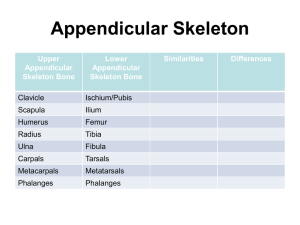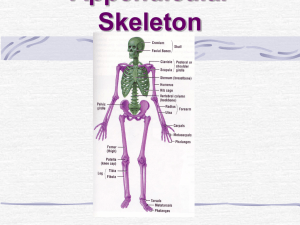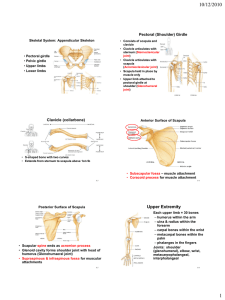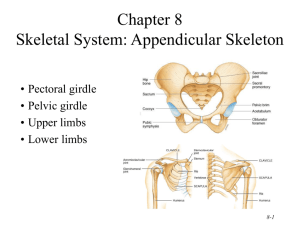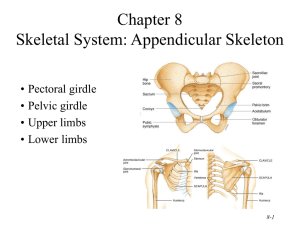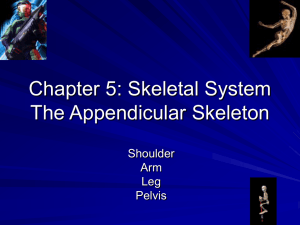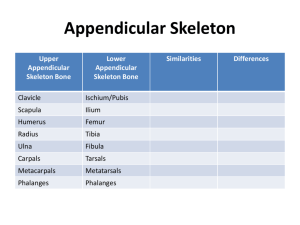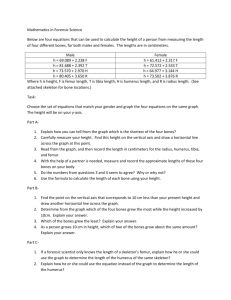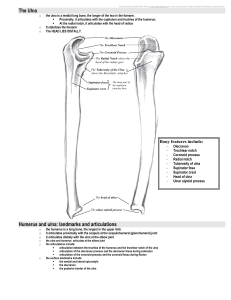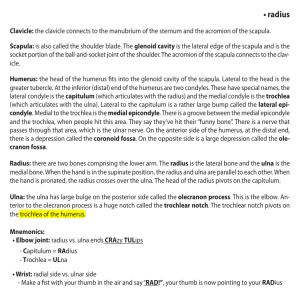Appendicular Skeleton Anatomy: Bones & Movement
advertisement
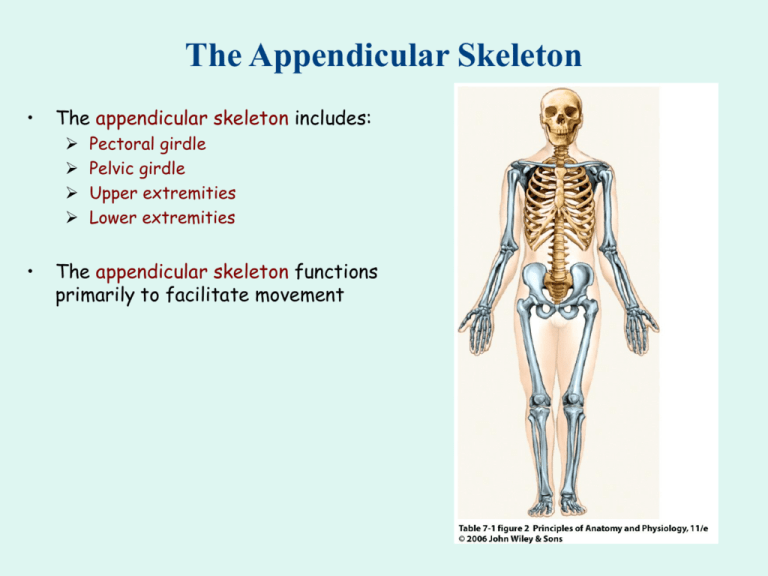
The Appendicular Skeleton • The appendicular skeleton includes: • Pectoral girdle Pelvic girdle Upper extremities Lower extremities The appendicular skeleton functions primarily to facilitate movement Pectoral (Shoulder) Girdle • • • • • • The pectoral or shoulder girdle attaches the bones of the upper limbs to the axial skeleton Consists of scapula & clavicle Clavicle articulates with sternum (sternoclavicular joint) Clavicle articulates with scapula (acromioclavicular joint) Scapula held in place by muscle only Upper limb attached to pectoral girdle at shoulder (glenohumeral joint) Clavicle (Collarbone) • • • • • • • S-shaped bone with two curves Extends from sternum to scapula above 1st rib Sternal & acromial extremities One of the most commonly fractured bones in the human body Fracture site is junction of curves Ligaments attached to clavicle stabilize its position. Shoulder separation is sprain of the acromioclavicular ligament Anterior Surface of Scapula • • • Articulates with the clavicle and the humerus Subscapular fossa filled with muscle Coracoid process for muscle attachment Posterior Surface of Scapula • • • • Triangular flat bone found in upper back region Scapular spine ends as acromion process Glenoid cavity forms shoulder joint with head of humerus Supraspinous & infraspinous fossa for muscular attachments Upper Extremity • Upper extremity consists of 30 bones • Humerus within the arm Ulna & radius within the forearm Carpal bones within the wrist Metacarpal bones within the palm Phalanges in the fingers Joints Shoulder (glenohumeral), elbow, wrist, metacarpophalangeal, interphalangeal Shoulder dislocation is separation of the humerus from the glenoid cavity of the scapula Shoulder Dislocation • • • Head of humerus slips out of glenoid cavity Closed reduction is term for slipping humerus back into place without surgery Severe or frequent dislocations may require surgical ligament repair Humerus: Proximal End • Largest and longest bone of upper extremity, part of shoulder joint, articulates with scapula • Head • Greater & lesser tubercles for muscle attachments • Intertubercular sulcus or bicipital groove • Shaft or body Humerus: Distal End • Forms elbow joint with ulna and radius • Capitulum articulates with head of radius • Trochlea articulation with ulna • Olecranon fossa posterior depression for olecranon process of ulna • Medial & lateral epicondyles attachment of forearm muscles Ulna & Radius: Proximal End • Ulna (on little finger side) Trochlear notch articulates with humerus & radial notch with radius Olecranon process forms point of elbow • Radius (on thumb side) Head articulates with capitulum of humerus & radial notch of ulna Tuberosity for muscle attachment Ulna & Radius: Proximal End • Radius (on thumb side) Head articulates with capitulum of humerus & radial notch of ulna Tuberosity for muscle attachment Ulnar notch articulates with ulna Elbow Joint • • • • Articulation of humerus with ulna and radius Ulna articulates with trochlea of humerus Radius articulates with capitulum of humerus Interosseous membrane between ulna & radius provides site for muscle attachment Ulna and Radius: Distal End • Ulna • Radius Styloid process provides attachment for ulnar collateral ligament Head separated from wrist joint by fibrocartilage disc Forms wrist joint with scaphoid, lunate & triquetrum Forms distal radioulnar joint with head of ulna 8 Carpal Bones (Wrist) • Proximal row - lateral to medial • Distal row - lateral to medial Scared Lovers Try Positions That They Can’t Handle Scaphoid: boat shaped Lunate: moon shaped Triquetrum: 3 corners Pisiform: pea shaped Trapezium: four sided Trapezoid: four sided Capitate: large head Hamate: hooked process Metacarpals and Phalanges • Metacarpals 5 total: #1 proximal to thumb base, shaft, head knuckles (metacarpophalangeal joints) • Phalanges (Digits) 14 total: each is called phalanx proximal, middle, distal on each finger, except thumb base, shaft, head Pelvic Girdle and Hip Bones • Pelvic girdle = two hip bones united at pubic symphysis • Each hip bone (os coxa) = ilium, pubis, and ischium • Bony pelvis = 2 hip bones, sacrum and coccyx articulate posteriorly with sacrum at sacroiliac joints fuse after birth at acetabulum Ilium • • • • • Iliac crest and iliac spines for muscle attachment Iliac fossa for muscle attachment Gluteal lines indicating muscle attachment Sacroiliac joint at auricular surface & iliac tuberosity Greater sciatic notch for sciatic nerve Ischium and Pubis • Ischium Ischial spine & tuberosity Lesser sciatic notch Ramus • Pubis Body Superior & inferior ramus Pubic symphysis is pad of fibrocartilage between 2 pubic bones Female Pelvis Male Pelvis • Many differences between the two • In particular, pubic arch in males is usually less than 90˚, whereas in females it is usually greater than 90˚ Lower Extremity • Each lower limb = 30 bones • femur and patella within the thigh tibia & fibula within the leg tarsal bones in the foot metatarsals within the forefoot phalanges in the toes Joints hip, knee, ankle proximal & distal tibiofibular metatarsophalangeal • The femur or thighbone is the largest, heaviest, and strongest bone of the body • It articulates with the hip bone and the tibia Head articulates with acetabulum Medial & lateral condyles articulate with tibia • Neck is common fracture site • Muscle attachments at greater & lesser trochanters, linea aspera, & gluteal tuberosity • Patellar surface is visible anteriorly between condyles Femur Femur • Fovea capitis in the center of the head • Medial epicondyles above the condyles • Intercondylar fossa between the condyles Patella • Triangular sesamoid bone • Apex & base • Articular facets for the femur • Increases leverage of quadriceps femoris tendon Tibia and Fibula Tibia (Shinbone) • Medial & larger bone of leg • Weight-bearing bone • Head • Lateral & medial condyles • Intercondylar eminence • Tibial tuberosity for patellar ligament • Proximal tibiofibular joint • Fibular notch • Medial malleolus at ankle Tibia and Fibula Fibula • Parallel and lateral to the tibia • Smaller than the tibia • Not weight bearing • Not part of the knee joint • Muscle attachments only • Head on proximal end, lateral maleolus at ankle • Fits into fibular notch at distal end of tibia Tarsals, Metatarsals, and Phalanges • Seven tarsal bones constitute the ankle (tarsus) and share the weight associated with walking • Five metatarsal bones are contained in the foot • Fractures of the metatarsals are common among dancers, especially ballet dancers, and also among martial artists • The arrangement of phalanges in the toes is the same as that described for the fingers and thumb above: fourteen bones in each foot Tarsus (Ankle) • Proximal region of foot (contains 7 tarsal bones) • Talus = ankle bone (articulates with tibia & fibula) • Calcaneus = heel bone • Cuboid, navicular & 3 cuneiforms • Metatarsal fractures occur when you drop something heavy on your foot Metatarsus and Phalanges • Metatarsals Midregion of the foot 5 metatarsals (#1 is most medial) Each with base, shaft and head • Phalanges Distal portion of the foot Similar in number and arrangement to the hand Big toe is hallux Arches of the Foot • Function distribute body weight over foot yield & spring back when weight is lifted • • Longitudinal arches along each side of foot Transverse arch across midfoot region navicular, cuneiforms & bases of metatarsals
